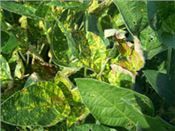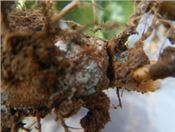|
Sudden Death Syndrome Of Soybean Being Observed In Some Soybean Fields
DR. CARL A. BRADLEY
PRINCETON, KY.
Symptoms of sudden death syndrome (SDS) of soybean have begun to appear over the last couple of weeks in Kentucky. Once soybean plants begin to go through reproductive growth stages, symptoms will first appear as yellow flecks that occur between the main veins of soybean leaves. These yellow flecks expand over time, and all areas of the leaf may turn yellow except the main veins, which is known as “interveinal chlorosis” (Figure 1). Eventually, these yellow areas will die, but the veins will still remain green (interveinal necrosis). These symptomatic soybean leaves will fall off prematurely, but the petioles will remain attached to the stem. Roots of SDS-affected plants may also be discolored brown, especially in the taproot. When conditions are just right, blue-colored masses of spores of the fungus that causes SDS (Fusarium virguliforme) might be observed on the roots (Figure 2).
Disease Development
Although above-ground symptoms generally are not observed until later in the season when plants begin going through reproductive stages, infection by the SDS pathogen actually takes place very early in the growing season. Within a few days after planting, when soybean seeds begin to germinate, the SDS pathogen can begin infecting the small radicle emerging from seeds. Infections that lead to severe disease generally occur when planting early in the spring, when soil temperatures may still be cool. This is especially true if rain occurs during these cool soil temperatures. If the growing season continues to be somewhat wet throughout the growing season, SDS symptoms are even more likely.
Disease Management
Soybean Variety
The first step in management of SDS is to choose a soybean variety with a high level of resistance. Since SDS has been in our area for over 30 years, seed companies have been able to breed for varieties with a high level of resistance, but there are still cases where a susceptible variety may slip through the cracks and be planted in our area.
Seed Treatments
In the last few years, two seed treatments with good efficacy against SDS have become available, which are ILeVO (BASF Corp.) and Saltro (Syngenta Crop Protection). Although these seed treatments work well, they will not provide 100 percent protection against the SDS pathogen, especially if a susceptible variety is grown under conditions very favorable for SDS.
Foliar Products
In multi-state university research trials conducted, applications of different foliar-applied products did not reduce SDS, which means that there currently are no products that can be applied “in-season” that will provide proven efficacy against SDS. A summary of these multi-state university research trials is available on the Crop Protection Network.
Managing SCN
Although the presence of soybean cyst nematode (SCN) in a field may increase the risk of SDS, the presence of SCN is not required for SDS to occur. However, management of SCN may help reduce the risk of SDS. For more information on managing SCN, please read this past Kentucky Pest News article..
Distinguishing SDS from other Soybean Diseases
If observing SDS symptoms in the field, it is important to know that other diseases and factors may cause similar symptoms. The Sudden Death Syndrome publication on the Crop Protection Network lists several of these diseases and factors that may cause similar symptoms, with information on how to distinguish them from SDS. Of those listed in the publication, southern stem canker and triazole fungicide phytotoxicity would be the two that would be most common. ∆
DR. CARL A. BRADLEY: Plant Pathology Extension Specialist, University of Kentucky

Figure 1. A range of symptoms of sudden death syndrome on soybean leaves, including
interveinal chlorosis and interveinal necrosis.
Photo: Carl Bradley, UK

Figure 2. Blue colored masses of spores of the sudden death syndrome (SDS) fungus (Fusarium
virguliforme) that may sometimes be observed on plants affected by SDS.
Photo: Carl Bradley, UK
|
|